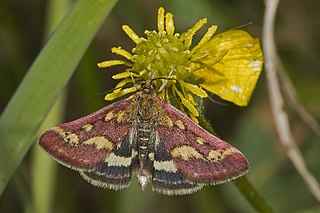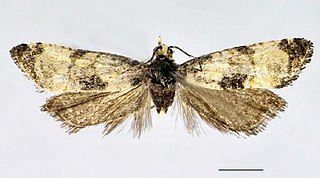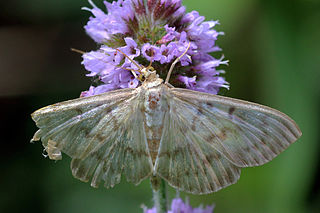Related Research Articles

Apamea monoglypha, the dark arches, is a moth of the family Noctuidae. The species was first described by Johann Siegfried Hufnagel in 1766. It is a common, sometimes abundant, European species. It is found in most of Europe except northernmost Fennoscandia and the southern parts of the Iberian Peninsula and Greece. The species is also found in Anatolia, Turkestan, Western Asia and Central Asia, Siberia and Mongolia. In the Alps it is found up to heights of 2,500 meters. The smaller subspecies sardoa is found on Sardinia and Corsica.

Apamea crenata, known as the clouded-bordered brindle, is a moth in the family Noctuidae. It is distributed throughout the Palearctic realm. In the North it crosses the Arctic Circle, in the Mediterranean it is found only in cool locations and mountains avoiding very hot areas. In the Alps, it rises to an altitude of about 2000 metres.

Apamea remissa, the dusky brocade, is a species of moth of the family Noctuidae. It is distributed throughout Europe and Turkey, ranging across the Palearctic realm to Siberia, Manchuria and Japan. It has also been reported from Alaska.

The small lappet moth is a moth in the family Lasiocampidae. The species was first described by Carl Linnaeus in his 1758 10th edition of Systema Naturae. It is found throughout Europe and parts of Asia.

Dysgonia algira, the passenger, is a moth of the family Noctuidae. The species was first described by Carl Linnaeus in 1767 and is found in the Palearctic - from the southern half of Europe and parts of North Africa through West, Central and South Asia.

Pyrausta despicata, the straw-barred pearl, is a species of moth of the family Crambidae. It was described by Giovanni Antonio Scopoli in his 1763 Entomologia Carniolica.

Pyrausta purpuralis is a species of moth of the family Crambidae. It was described by Carl Linnaeus in his 1758 10th edition of Systema Naturae and is found in Europe. The species closely resembles Pyrausta aurata and Pyrausta ostrinalis. It is also known by the common name Common Purple & Gold.

Scoparia ambigualis is a species of moth of the family Crambidae described by Friedrich Treitschke in 1829. It is found in Europe and Asia Minor and possibly in Guangdong and Shanxi in China.

Paratalanta pandalis is a species of moth of the family Crambidae. It is found in the Palearctic including Europe.

Catocala sponsa, the dark crimson underwing, is a species of moth of the family Erebidae. It is found in Europe, North Africa and from Anatolia up to the Caucasus.

Epinotia solandriana is a moth of the family Tortricidae. It is found in Europe, China, Korea, Japan, and Russia.

Dasystoma salicella, sometimes also known as the blueberry leafroller, is a moth of the family Lypusidae. It is endemic to Europe, but is an introduced species in North America.

Eublemma minutata, the scarce marbled, is a species of moth of the family Erebidae. It can be found everywhere in Europe, except for Luxembourg, the Netherlands, the northern part of Russia and various islands. In Asia, it can be found only in Lebanon.

Elachista freyerella is a moth of the family Elachistidae that is found in all of Europe, except the Balkan Peninsula. It is also found in North America.

Orthosia gracilis, the powdered Quaker, is a moth of the family Noctuidae. It is found in all of Europe except the extreme north and south, then east across the Palearctic to Northern Asia and Central Asia. O. g. pallidior is described from Xinjiang in China.

Trichiura crataegi, the pale eggar or pale oak eggar, is a moth of the family Lasiocampidae. It was first described by Carl Linnaeus in his 1758 10th edition of Systema Naturae. It is found in all of Europe, east to Anatolia and east across the Palearctic to Amur.

Orthotelia is a genus of moths in the subfamily Orthoteliinae.Orthotelia sparganella, a moth of the family Glyphipterigidae, is its only species.

Cochylis dubitana, the little conch, is a moth of the family Tortricidae. It is found in China (Heilongjiang) and most of Europe. and the Caucasus. It is also found in North America, where it has been recorded from Colorado, Maine, Ontario and Washington.

Mniotype adusta, the dark brocade, is a moth of the family Noctuidae. It was described by Eugenius Johann Christoph Esper in 1790. It is found throughout much of the Palearctic from Europe to Japan, China and Mongolia. It is also found in North America. The habitat consists of heathland, chalky downland, fenland, moorland and upland areas.

Patania ruralis, the mother of pearl moth, is a species of moth of the family Crambidae. It was described by Giovanni Antonio Scopoli in 1763. It is found in Europe.
References
- ↑ funet.fi
- ↑ Fauna Europaea
- ↑ Verh. zool.-bot. Ges. Wien, 49 : 178
 This article incorporates text from this source, which is in the public domain .
This article incorporates text from this source, which is in the public domain .